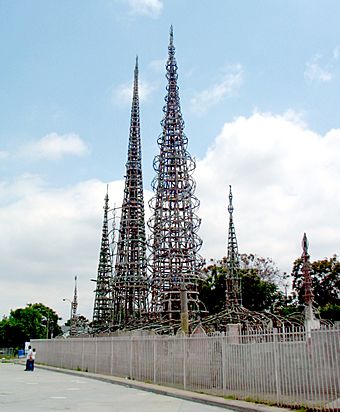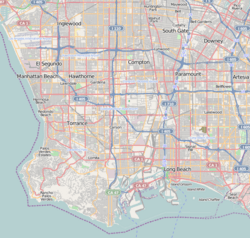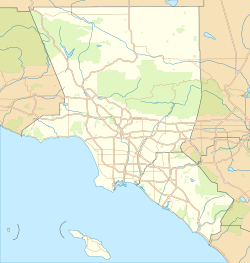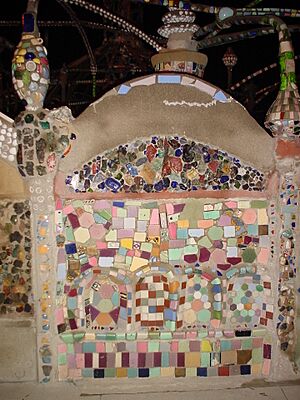Watts Towers facts for kids
|
Watts Towers of Simon Rodia
Simon Rodia State Historic Park |
|

Watts Towers
|
|
| Location | 1765 E. 107th Street, Los Angeles, California 90002 |
|---|---|
| Built | 1921–1954 |
| Architect | Sabato Rodia |
| NRHP reference No. | 77000297 |
Quick facts for kids Significant dates |
|
| Added to NRHP | April 13, 1977 |
| Designated NHL | December 14, 1990 |
The Watts Towers, also known as the Towers of Simon Rodia or Nuestro Pueblo (which means "our town" in Spanish), are a group of 17 amazing towers and sculptures. They are all connected and built on the land where the artist, Simon Rodia, used to live in Watts, Los Angeles, California.
Simon Rodia (1879 or 1886 to 1965) was an Italian immigrant who worked in construction. He designed and built these towers all by himself over 33 years, from 1921 to 1954. The tallest tower reaches almost 100 feet (30 meters) high! The Watts Towers are a great example of "outsider art," which means art made by people who haven't had formal art training.
These unique towers are very important. They were named a National Historic Landmark and a California Historical Landmark in 1990. They are also a Los Angeles Historic-Cultural Monument. The area around them is now called the Watts Towers of Simon Rodia State Historic Park.
Contents
Meet Simon Rodia
Sabato ("Simon" or "Sam") Rodia was born in Serino, Italy, in 1878. When he was 17, he moved to the United States with his brother. After his brother passed away in a mining accident, Rodia moved to Seattle, Washington. There, he married Lucia Ucci in 1902. They later moved to Oakland, where their three children were born.
Around 1909, Rodia got divorced. He then moved to Long Beach and worked many different jobs in construction. Finally, in 1920, he settled in Watts. He started building the Watts Towers in 1921. Many people called him "Sam."
How the Towers Were Built
Simon Rodia built the Watts Towers using simple hand tools and no special equipment. He didn't even have a set plan or design when he started! He called his creation "Nuestro Pueblo," meaning "our town."
Materials Used
The main parts of the towers are made from steel rebar (metal bars used to strengthen concrete) and a special type of concrete that Rodia mixed himself. He wrapped these structures with wire mesh. Then, he decorated them with all sorts of interesting things he found.
These decorations include:
Neighborhood children would often bring him broken pottery. He also used damaged pieces from local pottery companies. You can even spot old soda bottles from the 1930s to 1950s, like 7 Up and Canada Dry, in the green glass! The blue glass likely came from old milk of magnesia bottles.
Rodia bent the metal framework for the towers using nearby railroad tracks as a makeshift vise. He often walked nearly 20 miles (32 km) along the Pacific Electric Railway tracks to find materials.
Why Rodia Stopped Building
In 1954, Rodia had a mild stroke and fell from a low part of a tower. In 1955, he decided to give his property to a neighbor and left Watts. He was tired of dealing with the City of Los Angeles about building permits. He also mentioned that people in the neighborhood often damaged his towers. He moved to Martinez, California, to live with his sister and stayed there until he passed away in 1965.
Saving the Towers
After Rodia left, his house inside the tower area burned down in 1956. The City of Los Angeles then wanted to tear down the towers because they thought they were unsafe.
However, many people around the world wanted to save them! In 1959, an actor named Nicholas King and a film editor named William Cartwright bought the property to protect the towers. They, along with architects, artists, and community members, formed a group called the Committee for Simon Rodia's Towers in Watts.
This group worked with the city to allow a safety test. On October 10, 1959, engineers tested the towers. They found that the towers were very strong and could handle a lot of force. This test proved the towers were safe, and the city decided not to tear them down.
Keeping the Towers Safe Today
The Committee for Simon Rodia's Towers took care of the site until 1975. Then, they partnered with the City of Los Angeles, and later with the State of California in 1978. Today, the City of Los Angeles Cultural Affairs Department manages the towers. The Watts Towers Arts Center helps take care of them and offers tours.
In 2011, the Los Angeles County Museum of Art (LACMA) received money to check on the condition of the towers. They wanted to make sure the towers stayed strong and beautiful. Over time, weather can loosen pieces of tile and glass, which are carefully put back during ongoing restoration work. The towers were very strong during the 1994 Northridge earthquake, with only a few pieces shaking loose. LACMA started a big restoration project in 2017, and the site reopened in November 2022 after the work was finished.
California Historic Landmark Marker
There is a special marker at the site that says:
NO. 993 WATTS TOWERS OF SIMON RODIA – The Watts Towers are perhaps the nation's best known work of folk art sculpture. Using simple hand tools, cast off materials (glass, shell, pottery pieces and broken tile) Italian immigrant Simon Rodia spent 30 years building a tribute to his adopted country and a monument to the spirit of individuals who make their dreams tangible. Rodia's Towers inspired many to rally and preserve his work and protect it for the future.
Watts Towers Arts Center
Right next to the towers is the Watts Towers Arts Center. This community center opened in 1970. It offers art classes, mostly for young people and adults with special needs from the local area. They also have partnerships with CalArts and Sony Pictures, offering classes in media arts and piano.
Every year, on the last weekend of September, the center hosts the Day of the Drum and Jazz Festival. This event includes art and craft booths and live music.
Watts Towers Crescent Greenway
The Watts Towers Crescent Greenway is a short path for bikes and walkers right next to the Towers. It's about 0.2 miles long.
See also
 In Spanish: Watts Towers para niños
In Spanish: Watts Towers para niños







